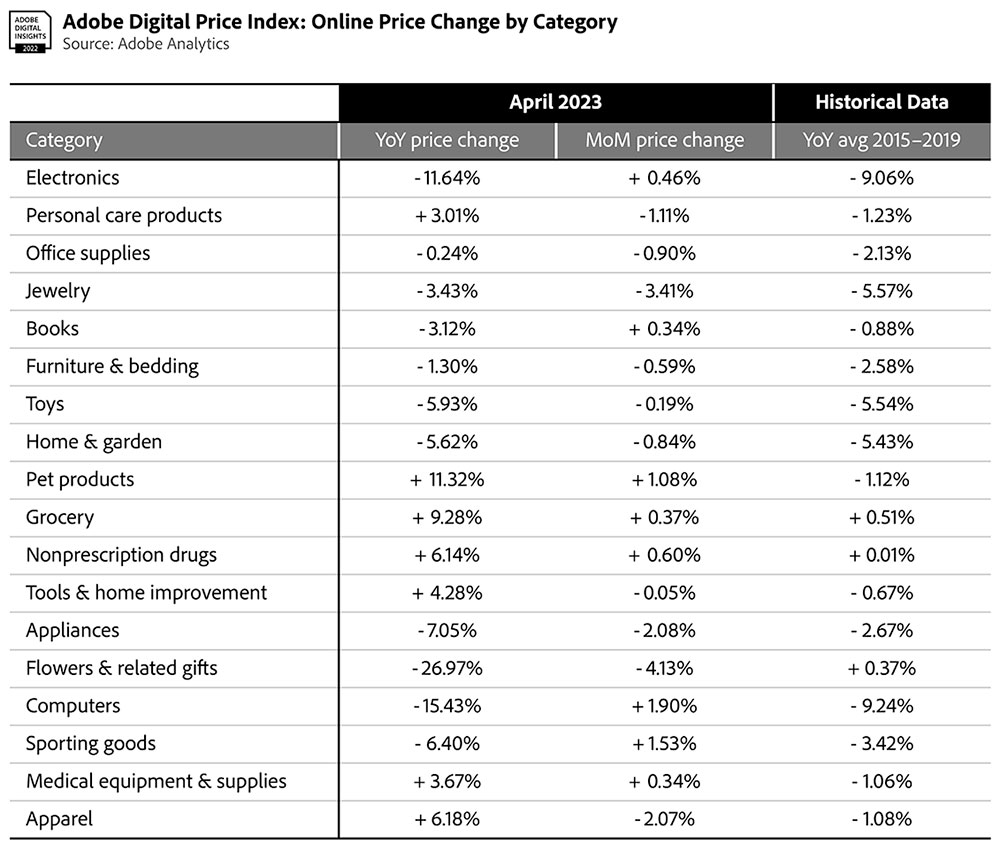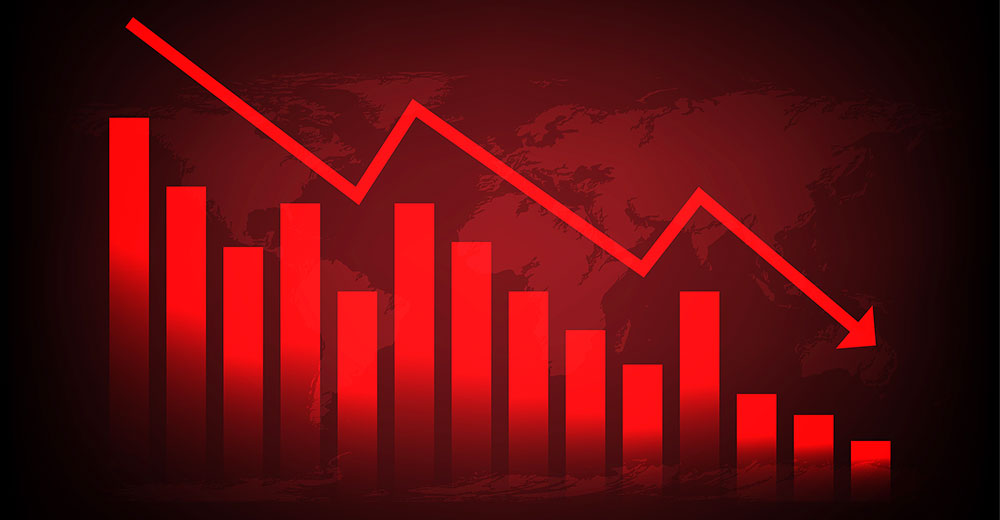Holy deflation! For the eighth month in a row, online prices have declined, according to the Adobe Digital Price Index, which analyzes one trillion visits to online retail sites and more than 100 million SKUs.
The index for April, released on Tuesday, showed a year-over-year decline in online prices of 1.8% and a month-over-month drop of 0.7%.
Eleven of the 18 product categories tracked by Adobe had year-over-year declines, led by computers with a 15.4% price drop during the period and followed by electronics (11.6%), appliances (7.1%), sporting goods (6.4%), toys (5.9%) and home and garden (5.6%).
Adobe noted that the 7.1% YoY dip in appliance prices was the largest decline in the category since the company began tracking online prices in 2014.
A combination of things has contributed to sinking appliance prices, according to Rob Enderle, president and principal analyst at the Enderle Group, an advisory services firm in Bend, Ore.
“There’s been a reduction in demand and, in anticipation of a recession, a reduction in appliance marketing,” he told the E-Commerce Times. “The result has been a decline in sales that is being offset by price reductions.”
Decreased Demand
“We are in a typically slow time of year,” Enderle added, “so some of these price reductions could be cyclical.”
“But demand has been dropping due to the high interest rates,” he continued, “and most of these categories are discretionary and not luxury offerings which often suffer when there is a broad reduction in demand or market downturn.”
“Higher interest rates put a damper on credit buying, which appears to be having an adverse impact on demand,” he explained. “These price drops are to mitigate that demand problem.”
“Demand that exceeds supply is one of the primary drivers of inflation. Another is an increase in supplier costs,” he added.
Enderle pinned the significant decline in electronics and computer prices to high interest rates and the pandemic.
“The pandemic saturated the market with relatively new products, and this market lives on churn,” he said, “but, additionally, this class of product is often purchased on credit, and with credit costs unusually high, demand has suffered.”
Adobe also pointed out that the price declines in sporting goods are coming at the end of an impressive string of price increases.
Prior to the current 12-month price dip, Adobe noted sporting goods prices rose for 28 consecutive months, starting in January 2020. Price increases peaked in September 2020 at 15.8% YoY, as more consumers stayed home during the Covid-19 pandemic and invested in products such as fitness equipment.
Bloated Inventory
Price trends in economic staples like oil and commodities have also contributed to the skid in online prices. “If you look at the prices for oil and other commodities, as well as shipping costs, a lot of that peaked last summer,” said David Swartz, an equity analyst with Morningstar Research Services in Chicago.
“The price of a lot of commodities, besides oil, have come down. For example, cotton prices have come way down in the last eight or nine months,” he continued.
“The first half of last year, shipping prices were very high,” he explained. “They’ve come down dramatically since then. That affects many categories because so many things are imported.”
“When shipping costs were sky high in 2021 and 2022, that drove up inflation,” he added.
Swartz noted that there had been a slowdown in sales in many of the product categories tracked by Adobe.
“We’ve also seen a lot of companies stuck with too much inventory, so they’ve had to discount products,” he said.
He cited the example of Under Armour, which had very weak gross margins in the March quarter. “It had to do a lot of discounting because it was stuck with a lot of inventory,” he explained. “That’s deflationary. It brings prices down.”
“We’ve seen that in a lot of other categories,” he continued. “It wasn’t a particularly strong Christmas season, so a lot of companies went into 2023 with excess inventory.”
“The idea that we’re seeing deflation in some categories is not surprising because we’ve seen slowing inflation in a number of costs to retailers in the last six months,” he added.
Price Drop Resistors
Not all product categories had price drops during the period covered by the Adobe report, most notably the groceries and personal care categories.
Although grocery prices rose 9.3% YoY (up 0.4% over the previous month), they have slowed in the past seven months from a peak of 14.3% YoY in September.
According to Adobe, consumers are increasingly buying more of their groceries online, and this category has generally moved in lock step with the Consumer Price Index.
Enderle maintained that costs and a mismatch of supply and demand continue to drive high prices in the grocery sector.
“The bird flu, flooding, and regional drought are all working to reduce supply while demand for this category remains constant,” he said. “Thus supply has dropped against consistent demand resulting in price increases largely due to environmental issues.”
In the personal care area, prices were up 3% compared to the previous year, a decrease from the previous month when its YoY increase was 4.4% and from the price sprint it experienced in February, climbing to a YoY change of 6.1%.
Adobe noted that this category had seen persistent inflation on a long-term basis, with only a single month since September 2020 that saw a year-over-year price fall. That was in November 2021, when its YoY dropped 0.9%.
“Personal care products are considered non-discretionary with stable demand regardless of market conditions. That appears to be the case still,” Enderle said.
“People will buy personal care items on a regular basis, even if the prices are higher,” Swartz added. “It may vary to a degree, but for the most part, the demand is inelastic. It doesn’t change that much. That isn’t the case for a lot of other categories.”
About the Abobe Digital Price Index
Adobe’s Digital Price Index does for online pricing what the Bureau of Labor Statistics’ Consumer Price Index does for offline prices.
Powered by Adobe Analytics, the DPI covers 18 product categories: electronics, apparel, appliances, books, toys, computers, groceries, furniture/bedding, tools/home improvement, home/garden, pet products, jewelry, medical equipment/supplies, sporting goods, personal care products, flowers/related gifts, non-prescription drugs, and office supplies.




























































Social Media
See all Social Media